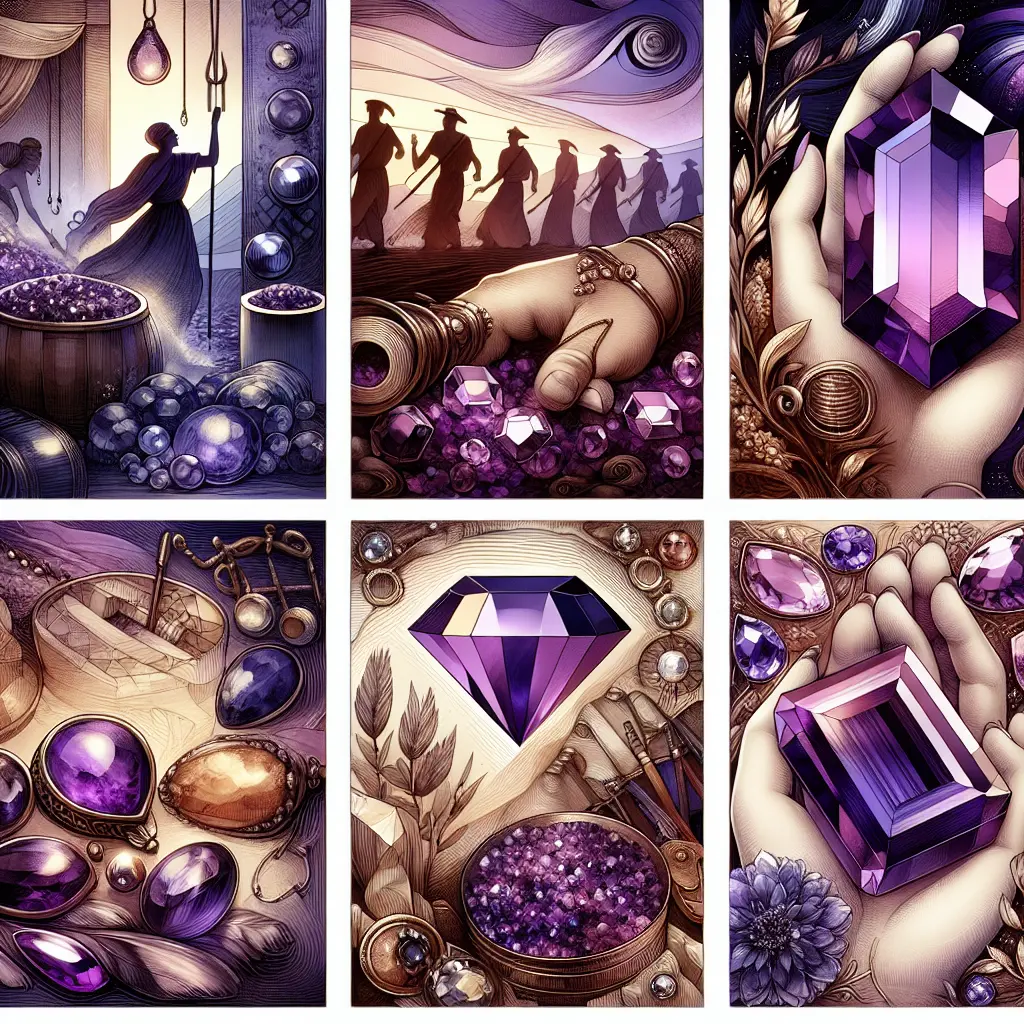Amethyst, a gemstone admired across civilizations, boasts a rich history steeped in mythology, symbolism, and spiritual significance. This alluring purple crystal has not only adorned jewelry but has also been a cornerstone in art, religion, and healing practices throughout human history. In this exploration of amethyst's past and present cultural impact, we delve into its historical uses and its continued relevance in today's world.
From the ancient Greeks to the Egyptians, amethyst has been revered for its beauty and supposed powers. The Greeks believed it could prevent intoxication, hence its name derived from "amethystos," meaning "not drunken." This belief was not just a mere myth but influenced how amethyst was perceived across various cultures.
The Romans embraced amethyst's protective qualities, often carving it into intaglios and seals, which were considered to bear the power to guard against deceit and evil. In Egypt, amethyst was used as an adornment in pharaohs' tombs, symbolizing the transition to the afterlife. The stone's deep purple hue was associated with the heart chakra and was believed to aid in spiritual enlightenment and balance emotional energies. Ancient Egyptian Amethyst Artifacts reveal the intricate craftsmanship and the value placed on this gemstone.
Throughout history, amethyst symbolism has been a narrative of transformation and protection. In Christian traditions, the stone represented purity and piety. Bishops wore amethyst rings as a symbol of their ecclesiastical authority, linking the stone to divine protection. Amethyst mythology is rich with tales such as that of Bacchus, the Roman god of wine, who spared a maiden named Amethyst from being devoured by tigers by turning her into a quartz statue.
Amethyst's historical uses extend far beyond mythology. In religion, it decorated religious artifacts and spaces; the famous medieval episcopal ring is one such example. In art, amethyst was often included in mosaics and religious iconography, embodying its spiritual significance. For instance, the Byzantine Empire utilized amethyst in their mosaics, where its color symbolized royalty and divine power.
The Timeless Allure of Amethyst
The allure of amethyst in jewelry is undeniable. Historically, it adorned crowns and scepters, signifying royalty and wisdom. The British Crown Jewels feature amethysts prominently, underscoring its regal associations. Today, amethyst remains a popular choice for both high-end and everyday jewelry, beloved for its vibrant color and affordability compared to other gemstones like diamonds or sapphires.
Amethyst folklore includes tales of spiritual journeys and personal transformation. Its spiritual meaning varies across cultures but often emphasizes protection, purification, and spiritual insight. Many believe that wearing amethyst can ward off negative energies and enhance one's intuition.
While exploring amethyst history, an intriguing parallel emerges with recent discoveries on Mars by NASA's Curiosity Rover. In 2023, the rover uncovered pure sulfur crystals on Mars—a first for the Red Planet (NASA Discovery). Although not amethyst, this discovery of vivid yellow crystals resonates with humanity's fascination with colored stones across cultures.
The cultural significance of amethyst extends into modern times through art, fashion, and technology. For instance, innovative solar panel technology is maximizing efficiency through advancements reminiscent of ancient reverence for gemstones (Solar Panel Technology). Just as past societies harnessed the power of crystals for spiritual purposes, today's technology seeks to harness natural resources for sustainable energy solutions.
Amethyst's Cultural Impact Today
Amethyst's influence is also seen in popular culture through video games like Capcom's "Kunitsu-Gami: Path of the Goddess," which combines strategy with community organizing (Video Game Inspiration). The game's emphasis on strategic planning echoes the historical uses of gemstones as protective talismans.
Additionally, fashion continues to draw inspiration from amethyst's rich hues. Olympic athletes' outfits often include subtle nods to cultural motifs, highlighting how traditional symbols remain relevant (Olympic Fashion Insights).
Amethyst's journey through history is a testament to its enduring charm and cultural significance. Here's a concise recap of its multifaceted impact:
Ancient Reverence: From the Greeks and Egyptians to the Romans, amethyst was more than a gemstone; it was a symbol of protection and spiritual enlightenment.
Modern Connections: Its influence extends into contemporary technology and culture, from solar panel innovations to video game design and fashion motifs.









Leave a Comment